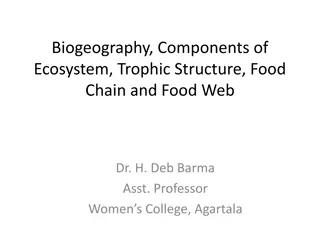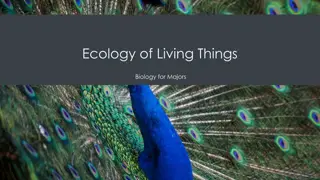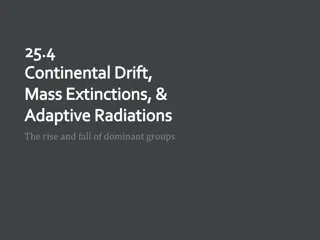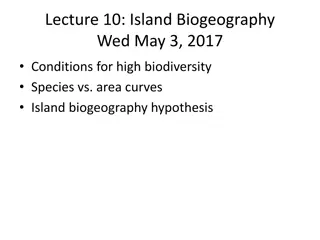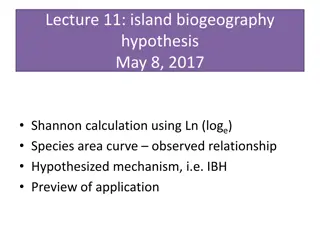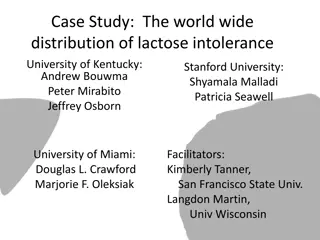Understanding Global Distribution Patterns of Animals in Climatology and Biogeography
Studying the distribution patterns of animals globally involves complex factors such as environmental conditions, zonal patterns, and latitudinal influences. Animal distribution is influenced by factors like sunlight availability, vegetation diversity, and evolutionary origins. Different animal zone
3 views • 20 slides
Understanding Biogeography, Ecosystem Components, Trophic Structure, Food Chain, and Food Web
Biogeography delves into the origin, distribution, and adaptations of plants and animals, aiding in earth surface differentiation. Ecosystems involve interactions between biotic and abiotic elements, forming trophic structures, biodiversity, and material cycles. Learn about the concepts, definitions
0 views • 29 slides
Understanding Biogeography: Patterns, Processes, and Scope
Biogeography explores the distribution of living organisms, past and present, analyzing ecological and evolutionary processes that shape these patterns. It encompasses plant and animal life, human impacts, and the spatial relationships within ecosystems. The field is divided into plant biogeography
1 views • 10 slides
Understanding Ecology: Interactions and Environments in Biology
Ecology is the study of interactions between living organisms and their environment. It involves levels of research such as animal ecology, plant ecology, and more, while also exploring the biosphere's impact, biogeography, species distribution patterns, and energy sources like sunlight. Ocean upwel
1 views • 80 slides
The Impact of Continental Drift on Earth's Biogeography
Continental drift, caused by the movement of tectonic plates, has had profound effects on Earth's habitats and the distribution of organisms. From the formation of supercontinents to the separation of land masses, these geological processes have led to climate change, speciation events, mass extinct
0 views • 17 slides
Island Biogeography and Biodiversity Factors
Explore the relationship between island size, distance from other communities, latitude, and time in relation to species richness and biodiversity. Factors influencing biodiversity are discussed in the context of island biogeography hypothesis. Analysis of species vs. area curves is presented, highl
0 views • 33 slides
Island Biogeography Hypothesis and Species-Area Curves Overview
Explore the Island Biogeography Hypothesis through Shannon calculations and Species-Area Curve observed relationships. Learn about the mechanisms of island biodiversity, generalizations of species richness, and equilibrium concepts. Discover how area size influences species diversity and the impact
0 views • 24 slides
Understanding Physical Geography: Branches and Concepts Explored
Physical geography is a field that studies natural processes on Earth's surface, providing the backdrop for human activities. It encompasses various branches like geomorphology, climatology, oceanography, biogeography, soil geography, and environmental geography. Geomorphology investigates landforms
0 views • 10 slides
Understanding Genetic Mechanisms and Lactose Intolerance Distribution
Explore the genetic foundations of lactose intolerance through a comprehensive study on gene concepts, transcription and translation mechanisms, regulation processes, and phenotypic outcomes. Engage with learning goals focused on genotype-phenotype relationships, scientific processes, and the unique
0 views • 15 slides

